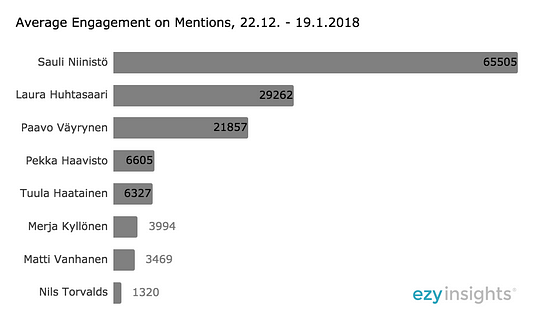While President Sauli Niinistö’s own Facebook presence is very modest, he was by far the most popular and widely covered candidate on Facebook during the 2018 Finnish Presidential Election. EzyInsights’ data shows how people engaged with media coverage of candidates and their Facebook pages’ content.
President Niinistö was clearly the most visible candidate on social media
President Sauli Niinistö (Independent, formerly National Coalition Party), was voted in for a second term with clear majority of votes, 62,7%. He led poll results, and his media coverage on Facebook was by far the biggest. Stories mentioning Niinistö also picked up the most Facebook engagement.


Niinistö’s popularity in social media is quite phenomenal. At the same time, extensive coverage throughout the year is also natural because he is the sitting President of Finland. In addition, Finland celebrated 100 years of Independence in 2017, which likely had a positive effect on Niinistö’s visibility. He has been a popular, stable President.
The gap narrowed towards the election
10 days before the election, controversial candidate Laura Huhtasaari, dubbed the “Marine Le Pen” of Finland, saw her monthly average of Facebook mentions rise to almost half of Niinistö’s. Paavo Väyrynen was third and Pekka Haavisto fourth.
The Green Party Candidate Pekka Haavisto, who came second in the Election, was the fourth biggest candidate on Facebook. Haavisto’s media coverage was rather low before the election, and could have benefited from a stronger social media presence.
Haavisto’s style was much less polemic than that of Laura Huhtasaari (Finns Party) and Paavo Väyrynen (Independent, formerly Centre Party), who came next after Niinistö on Facebook. Huhtasaari was second on Facebook and third in the Election results, and Väyrynen was third on Facebook and fourth in the Election results. They both are clearly in opposition to the current establishment and gained media visibility through debate.
Best engaging news about Niinistö, instead, were politically neutral and emotionally positive, such as birthday celebrations and baby news – he will shortly become a father again at age of 69. Everybody knows the family dog Lennu, who stole the show when Niinistö and his wife Jenni Haukio participated in an otherwise formal National event.
Niinistö picked up likes, Väyrynen and Huhtasaari comments
Niinistö’s Facebook page interactions were almost entirely likes (rather than other types of reactions, such as laughter or anger), with fewer comments and shares.
% of Shares, Comments and Reactions on each candidates’ Facebook page:
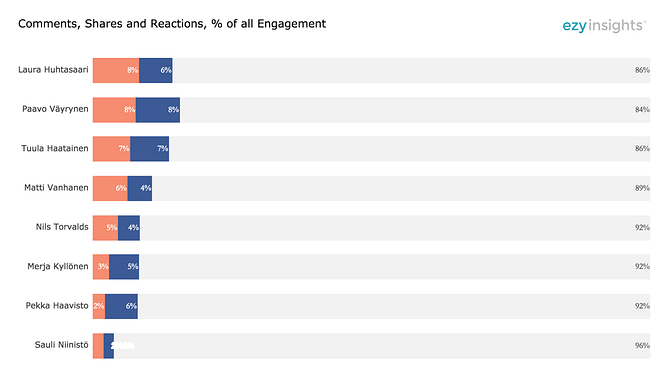
Likes are more neutral interactions than shares and comments, that may tell something about sharing values with the candidate, or eagerness to participate in debate. Väyrynen, Huhtasaari and Haatainen received typically more shares and comments than the other candidates. Tuula Haatainen (Social Democratic Party) over-performed in comments and shares. She placed 6th in the election, and while her total share of Facebook engagement was low in comparison to the top candidates, but she was able to engage people in discussion.
Huhtasaari, Väyrynen and Haatainen picked up the most comments. Vanhanen was the fourth most commented and Haavisto the fourth most shared.
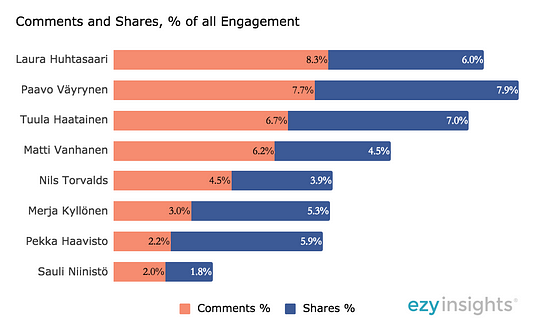
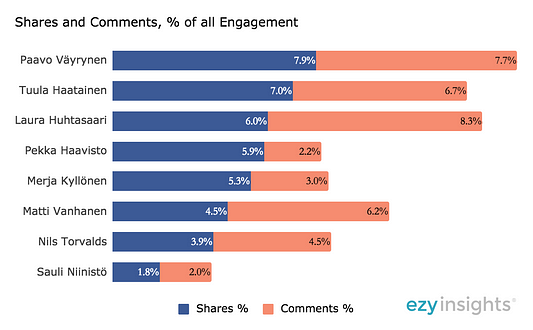
Haavisto and Kyllönen picked up many more shares than comments. This may reflect their subject matter, while being seen as valuable, it did not invite as much debate.
Next we examine data from a 10-day period just before the election 15.1.-25.1. 2018 (97,907 rows). It covers each candidate’s public Facebook page data and how people engage with their posts.
Väyrynen, Torvalds and Haatainen the most active
This is how many posts each candidate published before the election.
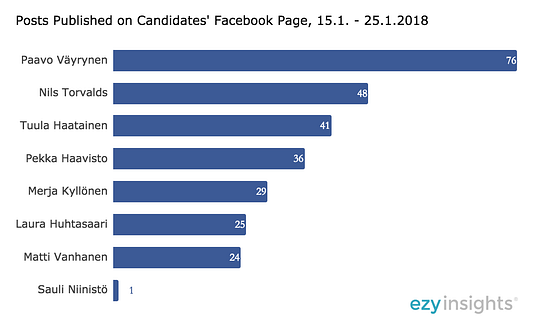
Väyrynen, Torvalds and Haatainen were the most active Facebook posters, whereas Niinistö’s page published only once during the period. It is logical that the less visible and sometimes also lesser known candidates post more, such as the Swedish-speaking minority candidate Nils Torvalds. The sitting President is already familiar to everybody.
Commenting tells about engagement with the politicians’ messages. Comments are often an expression of support, but they also contain challenging debate.
This is how many comments each candidate received:
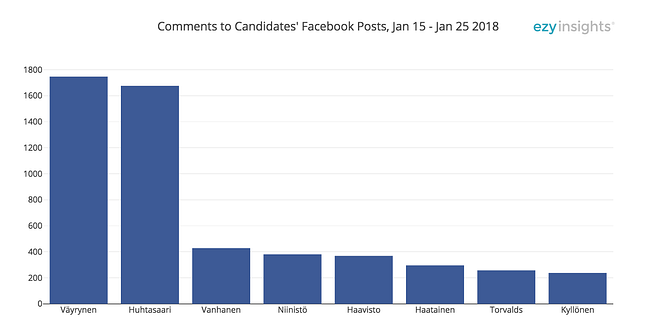
Väyrynen and Huhtasaari receive notably more comments than other candidates. This is not surprising due to their polemic style that aims at engaging people in political discussions.
Here are the politicians who had the most active commenters. The chart shows how many comments one user made on each politicians posts on average:
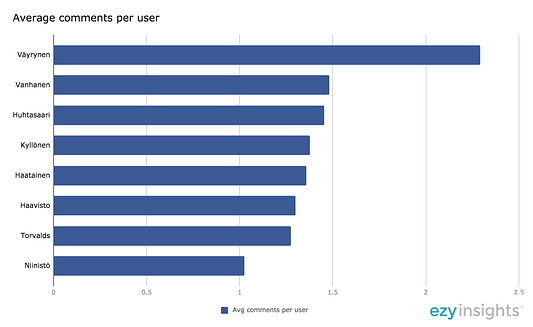
Väyrynen, Vanhanen and Huhtasaari had the most loyal commenters; people returned to comment on their posts most often. This was expected for Väyrynen and Huhtasaari, but for Vanhanen this is a new finding.
Here we see how many comments the top ten most active commenters sent to politicians’ posts:
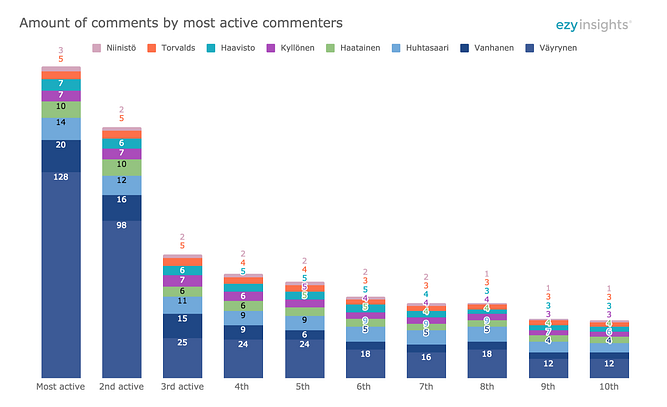
Väyrynen’s most active commenter made over 100 comments, whereas for Niinistö, the most active commenter sent only three.
Love, hate, anger, sadness?
If you’d like to know more about what kind of reactions each candidate typically gets, here is a little analysis on likes, love, hate, anger, sadness and awe for each candidate: https://medium.com/@varpurantala/finnish-election-reactions-who-are-the-most-loved-and-hated-candidates-on-facebook-48d1326fac0c
The Election was held on Sunday 28.1.2018.

Read more about EzyInsights analyses on Finnish Election:
EzyInsights is the leading news gathering and realtime analytics service used in over 100 newsrooms around the world. https://ezyinsights.com/
*Data
There are two datasets: one from circa one-year period from November 2016 to 22.1. 2018. It covers Finnish media publishers’ mentions of candidates during this period and audience engagement (comments, shares and reactions) to them (8,577 rows). The other is from a 10-day period just before the election 15.1.-25.1. 2018 (97,907 rows)

